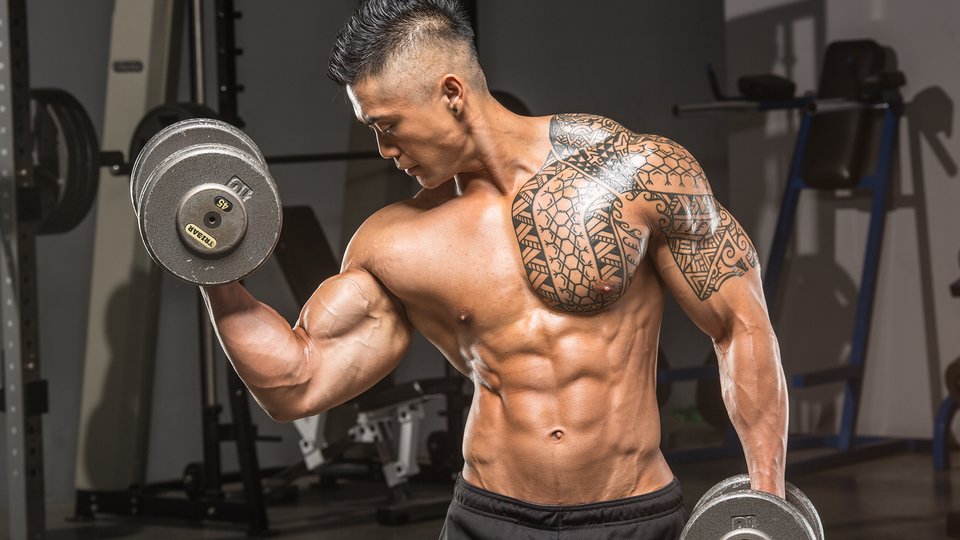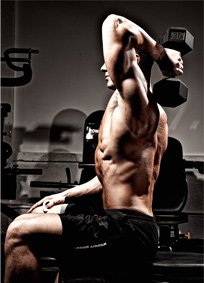I’m going to get your arms bigger, faster.
But first, a story.
My cellphone’s touchscreen is dead.
Now I’m waiting at the Apple Store, which I’m sure is one of Dante’s Circles of Hell.
First, it’s 45 minutes to see someone. Then, it’s another hour for them to complete the repair, which is silly because I know they’re just going to replace it anyway (they did).
Instead of wasting the next two hours, I started thinking about ways that I could be productive while I waited for my phone. So, I started plugging away on what is now this post.
I began to think about all kinds of activities, and how I could be more productive or multitask in those situations.
I could be dictating blog posts to my phone (when it’s fixed) while sitting in traffic! I could listen to audiobooks while doing household chores! My mind was racing with possibilities.
And then I came across a way in which we all wait around while doing nothing, and never think about it twice: resting between sets.
Now, I’m not saying that there isn’t a time and place for resting.
I’m also not talking about complexes (circuit-based workouts where you get a lot of work done in very little time). Nor am I talking about traditional supersets.
I’m willing to bet you have days where you push around some heavy weight. Like on Mondays, aka International Chest Day, you might be doing something like 5/3/1 or a 5×5 routine – basically heavier weights with low volume. You get under the bar, you crank out some tough reps, and you wait.
And you wait.
And you wait some more.
It’s not unusual to wait 2-3 minutes before being able to crank out another few reps at near-max effort on a lift like the bench press. If you’re doing five sets, you’ve literally spent 10-15 minutes waiting while your cardiovascular system and central nervous system recover. Squatting and deadlifting require even longer rest periods.
Well, what if you could get bigger biceps, broader shoulders, and thicker triceps, all while you wait?
You already know what I’m going to say.
Obviously, the answer is to work on your arms instead of just waiting around. Not so fast…
Yes, that is the idea, but let’s talk about the plan.

Well, what if you could get bigger biceps, broader shoulders, and thicker triceps, all while you wait?
Bigger Arms. No Waiting.
When focusing on specific body parts or lifts, you don’t want to do anything that will detract from the objective of the workout. For example, hitting triceps or shoulders between bench sets will fatigue the accessory muscles, and will probably affect your strength and endurance during subsequent sets.
However, training biceps during bench sets works well for a few reasons.
If you suffer from elbow tendinitis, one of the primary culprits is skipping warm ups. While I still don’t advocate that you skip your warm up (please don’t), doing bicep curls between bench sets will help reduce the pain, while not affecting your primary lift.
You’re bringing blood into the elbow joint, getting it warm and lubricated, so that you’re ready for a sweet, sweet upper body session.
And then, of course, you’re getting more bicep work in.
Then, when you’re doing heavy back work, hit those triceps between sets. You wouldn’t want to work shoulders or biceps for the same reasons as before: you’re cheating your main lift. However, working triceps makes complete sense. And you still get the same benefits of lubricating elbow joint and clocking in more reps.
Remember that you’re already working triceps and front delts during the bench press, and biceps and rear delts during your back exercise, so the volume, weights, and intensity of the arm work should be low.
Now just add a shoulder exercise of your choice to hit the lateral head of the shoulder towards the end of your workout and you’ve effectively had a complete arm day.
An upper body session might look something like this:
A1) Flat Bench Press – 5×5
A2) Barbell Curls (ever other set) – 3×10
B1) Barbell Row – 5×5
B2) Skull Crusher (every other set) – 3×10
C1) Incline DB Press – 4×8
C2) DB Row – 4×12
D1) Face Pulls – 3×10
D2) Lateral Raises – 3×10

Arnold sure as hell didn’t “wait” around for arm gains.
Never Skip Leg Day, Because It’s Also Arm Day
How about leg days?
When you squat, you normally pronate the wrist, which means that you grab the bar with your palms facing out. This stretches the bicep, and you don’t want your bicep to cramp up when you have heavy weights compressing your spine. This makes working triceps during the squat a better match.
Biceps for the deadlift works nicely, too, because some people tend to jerk the barbell a bit, using their biceps more than they should. While this is a form issue that needs to addressed, warming up the bicep during deadlifts will reduce the chance of injury.
Again, add some shoulder work to round out the arm training. In this case, I would recommend something like Seated Six Ways or Shoulder Killers, which targets the front, lateral, rear heads of the shoulder.
A1) Barbell back squat – 5×5
A2) Tricep Cable Pressdown (every other set) – 3×10
B1) Deadlift – 5×5
B2) Supinated DB Curls (every other set) – 3×10
C1) DB Lunge – 4×8
C2) Single-leg Romanian Deadlift – 4×12
D1) Swiss Ball Crunch – 3×15
D2) Shoulder Killers (performed here by my boy, Mike Vacanti of OnTheRegimen) – 3×12
A R M D A Y – C E P T I O N
Do you want build your arms while you rest from building your arms? Don’t worry, I got you, bro.
This time, instead of waiting between sets of a bicep exercise, for example, we’ll immediately move into a tricep exercise; it’s an arm day inside of an arm day.
Keeping the volume and intensity moderately high, and the weights moderately low, we want to make sure to work the arms from a few different angles. For example, you’d want to combine exercises that focus on stretching the muscle with others that focus more on flexing the muscle.
For example, an arm day might look something like this:
A1) Standing Barbell Curls – 3×10
A2) Incline Skull Crusher – 3×15
B1) Hammer Curls – 3×10
B2) Bench Dips – 3×15
C1) Overhead Single Arm Cable Curl – 3×8
C2) Cable French Press – 3×15
D1) Standing Single Arm Shoulder Press – 3×10
D2) Seated Six Ways (created by and performed here by John Meadows) – 3×12
A Note On Joints
This program will be fun; skin-splitting arm pumps always are. But you might be tempted to fly too close to the sun. By that, I mean that you’ll want to do this every time you’re in the gym. That, my friend, would be a bad idea.
You see, you’ll already using your biceps and triceps in all pulling and pressing movements, respectively, already. While all that arm volume will do wonders for growth, if you do it for it too long, your joints are going to get angry.
Like, really angry.
And much like David Banner said to Mr. Mcgee, don’t make them angry. You wouldn’t like them when they’re angry.
The routine provided here should only be followed for 4-8 weeks, at most, with an equally long break before it’s tried again. As slow as muscle growth can seem at times, it takes even longer for tendons and ligaments to catch up. Not giving the required time will at best, create nagging injuries that will hurt when you train or, at worst, keep you out of the gym altogether.

As slow as muscle growth can seem at times, it takes even longer for tendons and ligaments to catch up.
Good Things Come To Those Who Weight
You might be familiar with the concept of metabolic stress, which is muscle-building pathway that’s access when you do a lot of work in a small amount of time. Hitting arms on your upper body days will increase your overall training density.
Compare that to how many sets you’d normally do in a week for these body parts. Not only are you being more efficient by training arms during the rest periods of the heavy compound lifts, on both upper and lower body days, you’re also training your arms more frequently. In fact, the smallest muscles recover the fastest, so training them more often maximizes their potential for growth.
Bigger arms, faster. Just like I promised.
I guess waiting at the Apple Store wasn’t so bad after all.
About the Author
 Claudio Espinoza is a lover of all things 90’s, especially 90's hip-hop. When not working at his corporate job, he picks things up and puts them down, goes for long romantic walks with his French bulldog, and helps kids who can’t read good and want to do other stuff good, too
Claudio Espinoza is a lover of all things 90’s, especially 90's hip-hop. When not working at his corporate job, he picks things up and puts them down, goes for long romantic walks with his French bulldog, and helps kids who can’t read good and want to do other stuff good, too


